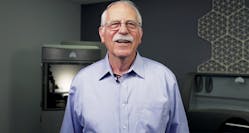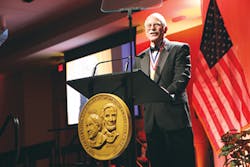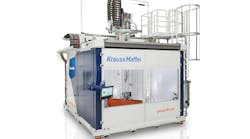As the inventor of stereolithography — the first commercial 3-D printing technology — and creator of the first 3-D printer, Chuck Hull is often called the "Father of 3-D printing." He has acquired more than 90 patents in his name, including one for stereolithography CAD software. While he likes to think that he has contributed to the growth of the plastics industry through his inventions, Hull is unwilling to single out any one for which he has particular pride, because, he said, "They are all my children, so I don't really have a favorite."
Hull discussed his career with PMM correspondent Lisa Jo Lupo.
How did your idea of stereolithography/ 3-D printing develop?
Hull: I had worked for many years at DuPont, then left there and went to UVP, a small company in California, as the head of R&D, where we developed applications in ultraviolet light. One of the applications was curing lamps for the evolving field of photocurable materials for coatings, inks, and such. I began to think that maybe there's a way we could image these materials in stacked-up layers and do prototyping for parts that were to be plastic injection molded. The problem back then, in the early 1980s, was that it took a long time between when you had a design to be molded and you had the first article as the part you wanted to mold. So, I set up a lab and conducted all kinds of experiments to see what could be done.
I finally ended up with the first prints from the first stereolithography device. I wanted to commercialize it, but the president of the company said he couldn't afford to do that. So that's when I spun off 3D Systems — the first company in 3-D printing.
With such a new technology, was it difficult to gain customers?
Hull: It was certainly a struggle. I needed venture capital to hire engineers to develop the technology, so I probably presented my plan to half the venture capitalists in California. They thought it was interesting, but about the only thing they were funding at the time were software and semiconductor companies. They just weren't familiar with the idea of something associated with manufacturing and engineering; it didn't appeal to them. A lot of manufacturing in those days was also starting to move offshore, so people thought the U.S. wouldn't manufacture anymore anyway. But, ultimately, my partner and I found a venture capital group in Vancouver, Canada, that thought it was a great idea, so they funded our startup.
Once you had funding, how did you get your first customers?
Hull: As we were developing the technology, we managed to get quite a bit of publicity in the trade press, so we got a lot of inquiries from people who thought it could be interesting for plastic prototypes and other models. We collected them all and started a beta program in '87-'88 of prospective customers that had the highest interest. We got a lot of interest from the Detroit auto companies, and developed two beta systems for GM. We also had betas with Pratt & Whitney, Kodak, and Baxter Healthcare, and these beta companies all became our first customers.
The technologies have a number of names: 3-D printing, stereolithography, additive manufacturing. Are all fundamentally the same?
Hull: They're really the same. I initially called the technology 3-D printing, then I wanted a more technical-sounding name — a five-dollar word instead of a fifty-cent word — so I came up with stereolithography. 3-D printing is the generic name; stereolithography has become known as the particular technique I first used, with a laser on a bed of photocurable material.
What has been the most important use of 3-D printing technology?
Hull: Probably the biggest application has been the prototyping of plastic parts. It's also used in general pattern making, and it has become one of the main techniques for pattern making. There also are a lot of applications in health care, which I hadn't really anticipated; and within that is dentistry. More and more 3-D printing has been used to streamline dental labs. In health care, surgical planning also became a very interesting topic to help surgeons visualize what their surgeries would be like; in combination with computer graphics, they give pretty good tools to surgeons to visualize what they're going to do; what the challenges are for the surgery. There's also 3-D printed models to duplicate the bone structure or the underlying structure they'll be operating on. Then, finally, there's the precision tools or guides for high-precision surgery. So, the whole area of surgical tooling/surgical planning became a field.
Beyond that, lots of implants are now manufactured in 3-D printing. Again, medical took a different, unique path than we anticipated early on. It's probably been the largest growing field in the last few years. And in the last 10 years, metal 3-D printing has come on as an interesting field with most of the applications being in medical and aerospace.
There's one other field, bioprinting, which is a huge, growing field in 3-D printing. It relates to printing things that are ultimately to be used in the body for a regenerative application. So, there's lots of research around the world in that. I think in the next five or 10 years, these kinds of applications will make major contributions to health care.
What do you see as 3-D printing's most promising application in plastics?
Hull: It has been very useful for prototypes for volume since the beginning. Now technology is evolving to make better parts much faster and with more durable materials, because the original materials were really not durable enough for production. There are constant improvements in materials, printing speeds, production speeds and so forth. So more and more, we see 3-D printing in the future as not just short-run production but maybe medium-run production and production where 3-D printing has an advantage, such as mass customization, or building parts that you can't easily tool.
It's been more than 30 years since your invention, but 3-D printing is really only just now coming into its own. Does that surprise you?
Hull: I would have expected that; almost every invention takes a long time before it's recognized and widely used. Fortunately, we developed a good market down in the bowels of manufacturing in prototyping and pattern making, so there's been a good, constant market for 3-D printing. But a general recognition by the public of what 3-D printing is has only evolved in the last few years.
Your company has grown significantly since its founding in 1986. To what do you attribute your success?
Hull: Success is always dependent on applications. So, almost all the growth in applications has come to us from customers. A customer will say, "I think we can use 3-D printing for this; what do you think? Can you help us?" So, we would work to improve the printer and develop software and materials for that customer, and that is how it has evolved. There also is a large chain of service bureau companies around the world who provide 3-D printing services for general manufacturing companies, and they've been on the forefront of the growth as well, because they're constantly finding new customers and applications. It's the applications, and the applications are driven largely by materials and other production in 3-D printing.
While your often-cited title as the "Father of 3-D printing" speaks for itself, what do you see as your greatest contribution to the plastics industry? What legacy will you leave behind?
Hull: The first thing is solving this problem of the first article, which really helped the plastics industry. It made it a lot more flexible and easier to see plastic parts. I like to think there was growth in the industry due to solving that problem. Another thing is that 3-D printing is a natural link to 3-D CAD. So, they grew simultaneously, especially in the manufacturing industry. So, again, I like to think there was a contribution in growth due to that linking of digital data to manufacturing.









